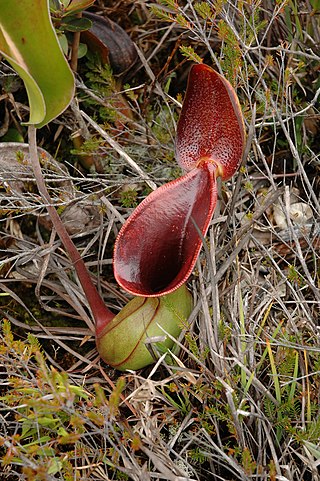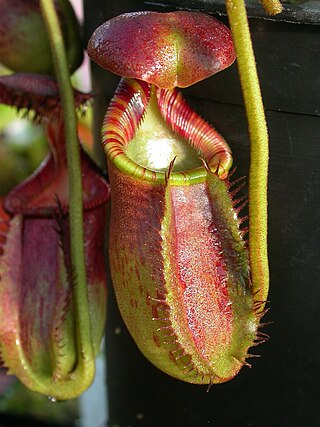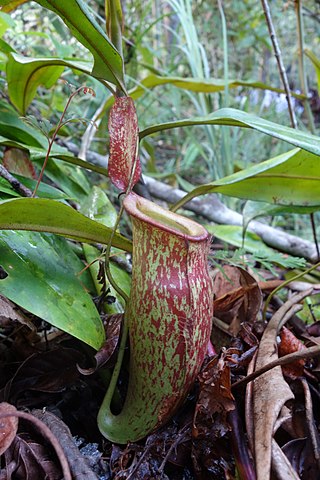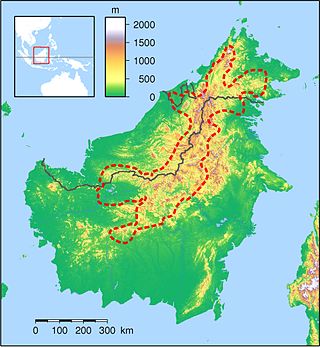
Brunei is a country in Southeast Asia, bordering the South China Sea and East Malaysia. Its geographical coordinates are 4°30′N114°40′E. The country is small with a total size of 5,765 km2 (2,226 sq mi). It is larger in size than Trinidad and Tobago. It is close to vital sea lanes through the South China Sea linking the Indian and Pacific Oceans. The country has two parts physically separated by Malaysia, making it almost an enclave within Malaysia.

Temburong District or simply Temburong is the easternmost district in Brunei. It is an exclave — the land is separated from the rest of the country by Malaysia and Brunei Bay, and accessible from the mainland via the Sultan Haji Omar Ali Saifuddien Bridge. It has a total area of 1,306 km2 (504 sq mi). The population was 10,251 in 2016; it is the least populous district in the country. Bangar is the district town and administrative centre.

Limbang is a border town and the capital of Limbang District in the Limbang Division of northern Sarawak, East Malaysia, on the island of Borneo. This district area is 3,978.10 square kilometres, and population was 56,900. It is located on the banks of the Limbang River, between the two halves of Brunei.

Nepenthes rafflesiana, or Raffles' pitcher-plant, is a species of tropical pitcher plant. It has a very wide distribution covering Borneo, Sumatra, Peninsular Malaysia, and Singapore. Nepenthes rafflesiana is extremely variable, with numerous forms and varieties described. In Borneo alone, there are at least three distinct varieties. The giant form of this species produces enormous pitchers rivalling those of N. rajah in size.

Nepenthes lowii, or Low's pitcher-plant, is a tropical pitcher plant endemic to Borneo. It is named after Hugh Low, who discovered it on Mount Kinabalu. This species is perhaps the most unusual in the genus, being characterised by its strongly constricted upper pitchers, which bear a greatly reduced peristome and a reflexed lid with numerous bristles on its lower surface.
Dr. Charles M. Clarke is an ecologist and botanist specialising in the carnivorous plant genus Nepenthes, for which he is regarded as a world authority. Clarke has an honours degree in Botany from Monash University in Melbourne, and a Ph.D. in Ecosystem management at the University of New England, in Armidale, New South Wales.

Nepenthes ephippiata, or the saddle-leaved pitcher-plant, is a tropical pitcher plant endemic to Borneo. It occurs in the Hose Mountains of central Sarawak, as well as Mount Raya and Bukit Lesung in Kalimantan. It grows in montane forest from 1,000 to 1,900 meters elevation.

Nepenthes pilosa is a tropical pitcher plant endemic to Borneo. It is characterised by a dense indumentum of long yellow-brown hairs. Pitchers have a distinctive hook-shaped appendage on the underside of the lid. The specific epithet derives from the Latin word pilosus, meaning "hairy".

Nepenthes hurrelliana is a tropical pitcher plant endemic to Borneo, where it has been recorded from northern Sarawak, southwestern Sabah, and Brunei. It is of putative hybrid origin; its two original parent species are thought to be N. fusca and N. veitchii. A thick indumentum of rusty-brown hairs covers the entire plant, a characteristic presumably inherited from the latter.

Nepenthes × trichocarpa, the dainty pitcher-Plant, is a common natural hybrid involving N. ampullaria and N. gracilis. It was originally thought to be a distinct species and was described as such.

Nepenthes × kuchingensis is a natural hybrid between N. ampullaria and N. mirabilis. Although it is named after the city of Kuching in Sarawak, this plant has a wide distribution across Borneo, New Guinea, Peninsular Malaysia, Sumatra, and Thailand.

Nepenthes chaniana is a tropical pitcher plant species belonging to the genus Nepenthes. It is characterised by a dense indumentum of long, white hairs. Pitchers are cylindrical and mostly white to yellow in colouration. Nepenthes chaniana belongs to the loosely defined "N. maxima complex", which also includes, among other species, N. boschiana, N. epiphytica, N. eymae, N. faizaliana, N. fusca, N. klossii, N. maxima, N. platychila, N. stenophylla, and N. vogelii.

The Lambir Hills National Park is a national park in Miri Division, Sarawak, Malaysia, on the island of Borneo. It is a small park, at 6,952 hectares, and is composed largely of mixed dipterocarp forest, with some small areas of 'kerangas'. The park is 150–465 m (492–1,526 ft) above sea level.

The following outline is provided as an overview of and a topical guide to Brunei:

The Borneo montane rain forests is an ecoregion on the island of Borneo in Southeast Asia. It includes montane tropical and subtropical moist broadleaf forests, also known as a cloud forests. The ecoregion is partly in East Malaysia and Indonesia (Kalimantan).

The Heart of Borneo is a conservation agreement initiated by the World Wide Fund for Nature to protect a 220,000 km² forested region on Borneo island. The agreement was signed by the governments of Brunei, Indonesia and Malaysia in Bali on 12 February 2007 to support the initiative. The region provides habitat to 10 endemic species of primates, more than 350 birds, 150 reptiles and amphibians and 10,000 plants. From 2007 to 2010 a total of 123 new species have been recorded in the region. A status report from 2012 found that the lowland rain forest within the area is deteriorating and under threat. The Bornean rhinoceros was the most threatened fauna, in 2015 three captive individuals remained in Sabah.
The Institute for Biodiversity and Environmental Research in Brunei Darussalam is a research institute of Universiti Brunei Darussalam (UBD) dedicated to biodiversity and environmental sciences research and education. IBER's location within the northwest Borneo hotspot offers unique opportunities for long-term studies in both terrestrial and marine tropical ecosystems.
Memecylon cantleyi is a shrub or tree species in the Melastomataceae family. The flowers are white and vivid blue. The plant is native to an area from Borneo to Sumatra to Thailand. A name given to the tree in Malaysia, nipis kulit, translates as "calamondin bark".

Retak Hill, is one of the major hills shared between Mukim Amo, Temburong District of Brunei and Limbang Division, Sarawak of Malaysia.
Tudal Hill, is one of the major hills shared between Mukim Amo, Temburong District of Brunei and Limbang Division, Sarawak of Malaysia.


















